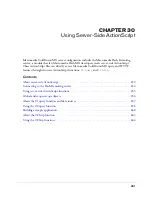
Using Flash with ColdFusion components
647
To create a ColdFusion component that interacts with a Flash movie:
1
Create a ColdFusion component, and save it as flashComponent.cfc in the helloExamples
directory.
2
Modify the code in flashComponent.cfc so that it appears as follows:
<cfcomponent name="flashComponent">
<cffunction name="helloWorld" access="remote" returnType="Struct">
<cfset tempStruct = StructNew()>
<cfset tempStruct.timeVar = DateFormat(Now ())>
<cfset tempStruct.helloMessage = "Hello World">
<cfreturn tempStruct>
</cffunction>
</cfcomponent>
In this example, the
helloWorld
function is created. The
cfreturn
tag returns the result to
the Flash movie.
3
Save the file.
The
helloWorld
service function is now available through the
flashComponent
service to
ActionScript. The following ActionScript example calls this function:
#include "NetServices.as"
NetServices.setDefaultGatewayUrl("http://localhost:8500/flashservices/
gateway");
gatewayConnection = NetServices.createGatewayConnection();
CFCService = gatewayConnection.getService("flashExamples.flashComponent",
this);
CFCService.helloWorld();
In this example, the
getService
references the flashComponent component in the
flashExamples directory. You can now call the CFCService object
sayHello
and
getTime
functions.
For ColdFusion components, the component file name, including the directory structure from
the web root, serves as the service name. Remember to delimit the path directories rather than
backslashes.
Using component metadata with the Flash Remoting service
Flash MX designers can use the Service Browser in the Flash MX authoring environment to
discover business logic functionality built in ColdFusion. You use the
description
attribute of
the
cffunction
and
cfargument
tags to describe the ColdFusion functionality to the Service
Browser.
To create a ColdFusion component that describes itself to the Service Browser:
1
Open
flashComponents.cfc
, and modify the code so that it appears as follows:
<cfcomponent name="flashComponent">
<cffunction name="helloWorld" access="remote" returnType="Struct"
description="Returns hello message">
<cfset tempStruct = StructNew()>
<cfset tempStruct.timeVar = DateFormat(Now ())>
<cfset tempStruct.helloMessage = "Hello World">
<cfreturn tempStruct>
</cffunction>
</cfcomponent>
Содержание ColdFusion MX
Страница 1: ...Developing ColdFusion MX Applications...
Страница 22: ...22 Contents...
Страница 38: ......
Страница 52: ...52 Chapter 2 Elements of CFML...
Страница 162: ......
Страница 218: ...218 Chapter 10 Writing and Calling User Defined Functions...
Страница 250: ...250 Chapter 11 Building and Using ColdFusion Components...
Страница 264: ...264 Chapter 12 Building Custom CFXAPI Tags...
Страница 266: ......
Страница 314: ...314 Chapter 14 Handling Errors...
Страница 344: ...344 Chapter 15 Using Persistent Data and Locking...
Страница 349: ...About user security 349...
Страница 357: ...Security scenarios 357...
Страница 370: ...370 Chapter 16 Securing Applications...
Страница 388: ...388 Chapter 17 Developing Globalized Applications...
Страница 408: ...408 Chapter 18 Debugging and Troubleshooting Applications...
Страница 410: ......
Страница 426: ...426 Chapter 19 Introduction to Databases and SQL...
Страница 476: ...476 Chapter 22 Using Query of Queries...
Страница 534: ...534 Chapter 24 Building a Search Interface...
Страница 556: ...556 Chapter 25 Using Verity Search Expressions...
Страница 558: ......
Страница 582: ...582 Chapter 26 Retrieving and Formatting Data...
Страница 668: ......
Страница 734: ...734 Chapter 32 Using Web Services...
Страница 760: ...760 Chapter 33 Integrating J2EE and Java Elements in CFML Applications...
Страница 786: ...786 Chapter 34 Integrating COM and CORBA Objects in CFML Applications...
Страница 788: ......
Страница 806: ...806 Chapter 35 Sending and Receiving E Mail...






























